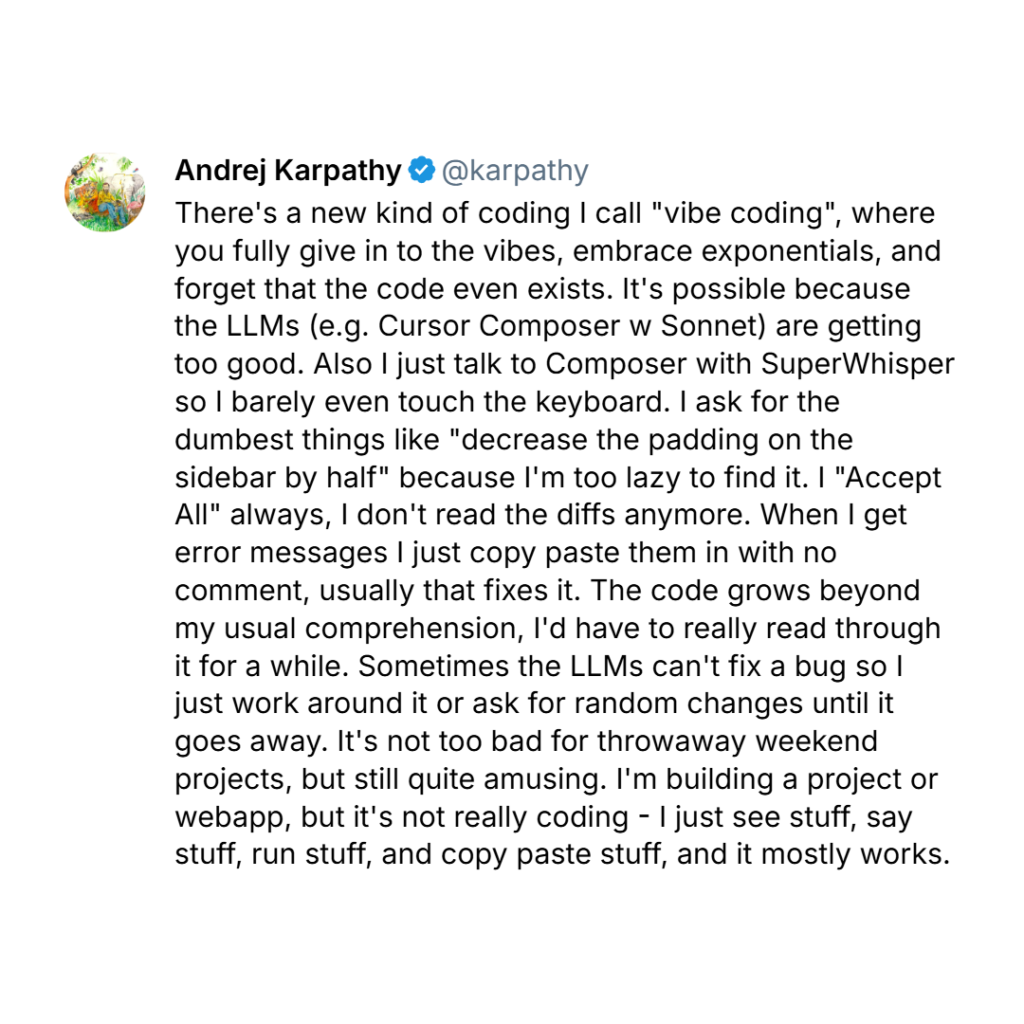When Andrej Karpathy tweeted about “vibe coding,” it got developers talking. He described a workflow where you hand off the heavy lifting to AI and follow the flow it creates.
It resonated with a lot of people. But it raises a better question.
Is vibe coding the future of software development, or just another hype?
Vibe Coding Explained
Picture a junior developer who knows the basics but keeps second-guessing your decisions. They jump ahead. They miss the point. They ignore direction. Without clear guidance, they create more work than they save.
That’s what vibe coding feels like.
Vibe coding is the idea of using AI to handle the boring, repetitive parts of development while you stay focused on the bigger picture. The machine does the grunt work. You set the direction.
But after more than a decade working with developers, it’s worth asking what vibe coding really brings to the table.
What Karpathy Actually Meant by “Vibe Coding”

In his viral tweet, Karpathy described vibe coding as “embracing exponentials and forgetting the code even exists.” He pointed to tools like Cursor Composer, Sonnet, and SuperWhisper, where you speak commands, paste error messages, and let the AI handle most of the thinking and coding.
But he’s not saying developers should stop understanding code. The point is about changing how we work with it. Instead of writing out boilerplate, you describe what you want. The AI handles the rest.
It’s not a replacement. It’s collaboration.
The Future of Coding with AI
- Vibe coding isn’t here to take your job. It’s here to work with you. It shifts development from a solo task to a two-way conversation. You set the direction. The AI helps you get there.
From Code Monologue to Dialogue
- Instead of coding alone, you’re now working alongside an AI that listens, responds, and helps shape your ideas. You describe what you need, ask questions, refine your thinking—and the AI contributes too. It suggests better approaches, flags potential issues, and helps you write cleaner, smarter code.
You Focus on the Vision, Not the Syntax
- With vibe coding, you don’t have to get lost in repetitive boilerplate or nitty-gritty details. You focus on what you want to build, and the AI handles the how.
- It’s like saying, “I need a function to recommend products based on purchase history,” and watching the logic appear—no need to manually write every line. You stay in the creative zone, solving problems and shaping the outcome.
Let AI Handle the Tedious Stuff
- All those repetitive tasks—writing helper functions, dealing with auth, validating forms—they don’t need to eat up your time anymore. The AI can handle them quickly, so you can stay focused on solving real problems and building features that actually matter.
You’re Still Driving the Ship
- The AI can write the code, but it’s not making the decisions. You’re still the one shaping the direction, reviewing what it suggests, and making sure everything works the way it should. It’s your project—the AI just helps you get there faster.
Vibe Coding: Game-Changer or False Promise?
Karpathy’s workflow makes bold claims to hook is followers —let’s examine them realistically:
“I ‘Accept All’ always, I don’t read the diffs anymore.”
- While this speeds up iteration, blindly accepting AI-generated changes risks letting subtle bugs or security gaps slip through. Most teams still require human review for critical code.
“When I get error messages, I just copy-paste them in with no comment, usually that fixes it.”
- AI is surprisingly adept at parsing errors, but it can misinterpret context. Relying solely on this habit might solve immediate issues while masking deeper problems. Understanding errors still matters.
“The code grows beyond my usual comprehension.”
- This is the real red flag. Codebases that evolve without human oversight become technical debt time bombs—hard to debug, harder to maintain.
- For quick prototypes or personal projects? Maybe viable. For production systems? Human judgment remains non-negotiable. The “vibe” can’t replace vigilance.
The Upsides of Vibe Coding
Karpathy’s approach might sound extreme, but there’s real value in parts of it—if you’re careful.
Faster Prototyping
You can go from “I want an app that does X” to “here’s a working version” in minutes instead of days. No more wasting time writing boilerplate just to test an idea.
Less Mental Fatigue
- Instead of burning energy on tedious stuff—like setting up API endpoints or writing yet another CRUD function—you focus on the actual logic and design. The AI handles the repetitive grunt work.
More Accessible Building
- Someone who knows basic programming concepts but isn’t an expert can still create something functional. You don’t need to memorise every library or syntax quirk—just explain what you need clearly.
Easier Experimentation
- Want to try three different ways to solve a problem? The AI can generate each version quickly, so you can compare and pick the best one without rewriting everything from scratch.
The Downsides of Vibe Coding
It’s not all smooth sailing, though.
You’re Stuck If the AI Fails
- What if the AI service goes down? Or the model changes and starts giving worse answers? Relying too much on it means you might hit a wall when you suddenly have to code manually again.
Shallow Understanding
- If you never dig into how the code actually works, you’ll struggle when things break. It’s like driving a car without knowing how to change a tire—fine until you’re stranded on the highway.
Debugging Nightmares
- AI-generated code can be messy. When something fails, you might waste hours untangling weird, overly complex solutions instead of fixing a simple issue.
Hidden Problems
- The AI doesn’t always care about security, efficiency, or clean code. It might give you something that works but is slow, insecure, or impossible to update later.
The Bottom Line
Vibe coding is useful for quick tests, rough drafts, or small projects. But for anything serious, you still need to understand what’s happening under the hood—otherwise, you’re just stacking up future problems.

